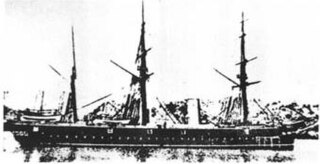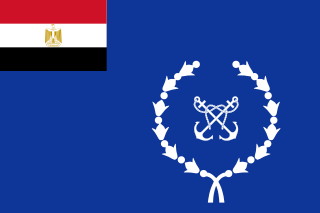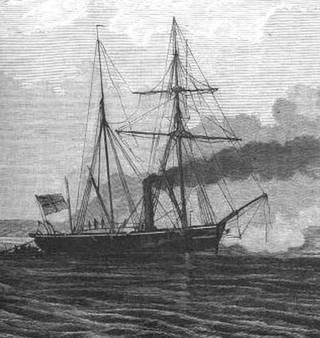
The first USS Trenton was a wooden-hulled screw steamer, classified as a screw frigate, in the United States Navy. She was named for Trenton, New Jersey.

USS Klakring (FFG-42), an Oliver Hazard Perry class frigate, was a ship of the United States Navy named for Rear Admiral Thomas B. Klakring (1904–1975), who was awarded three Navy Crosses as commander of the submarine USS Guardfish during World War II.

Kongō was the lead ship of the Kongō-class ironclad corvettes built for the Imperial Japanese Navy (IJN) in the 1870s. The class was built in the United Kingdom because such ships could not yet be constructed in Japan. Completed in 1878, Kongō briefly served with the Small Standing Fleet before becoming a training ship in 1887, thereafter making training cruises to the Mediterranean and to countries on the edge of the Pacific Ocean. The ship returned to active duty during the First Sino-Japanese War of 1894–95 where she participated in the Battle of Weihaiwei. Kongō resumed her training duties after the war, though she also played a minor role in the Russo-Japanese War of 1904–05. The ship was reclassified as a survey ship in 1906 and was sold for scrap in 1910.

Hiei was the second and last vessel of the Kongō-class ironclad corvettes built for the Imperial Japanese Navy (IJN) in the 1870s. They were built in the United Kingdom because the Japanese were unable to build ironclad warships in Japan. She became a training ship in 1887 and made training cruises to the Mediterranean and to countries on the edge of the Pacific Ocean. The ship returned to active duty during the First Sino-Japanese War of 1894–1895 where she was damaged during the Battle of the Yalu River. Hiei also participated in the Battle of Weihaiwei and the invasion of Formosa in 1895. The ship resumed her training duties after the war, although she played a minor role in the Russo-Japanese War of 1904–1905. She was reclassified as a survey ship in 1906 and was sold for scrap in 1912.

The Egyptian Navy, also known as the Egyptian Naval Force, is the maritime branch of the Egyptian Armed Forces. It is the largest navy in the Middle East as well as Africa, and is the twelfth largest navy in the world. The navy protects more than 2,000 kilometers of coastline of the Mediterranean Sea and the Red Sea, defense of approaches to the Suez Canal, and it also supports for army operations. The majority of the modern Egyptian Navy was created with the help of the Soviet Union in the 1960s. The navy received ships in the 1980s from China and Western sources. In 1989, the Egyptian Navy had 18,000 personnel as well as 2,000 personnel in the Coast Guard. The navy received ships from the US in 1990. US shipbuilder Swiftships has built around 30 boats for the Egyptian Navy including mine hunters, survey vessels, and both steel and aluminium patrol boats.

HMS Penelope was a central-battery ironclad built for the Royal Navy in the late 1860s and was rated as an armoured corvette. She was designed for inshore work with a shallow draught, and this severely compromised her performance under sail. Completed in 1868, the ship spent the next year with the Channel Fleet before she was assigned to the First Reserve Squadron in 1869 and became the coast guard ship for Harwich until 1887. Penelope was mobilised as tensions with Russia rose during the Russo-Turkish War of 1877–78 and participated in the Bombardment of Alexandria during the Anglo-Egyptian War of 1882. The ship became a receiving ship in South Africa in 1888 and then a prison hulk in 1897. She was sold for scrap in 1912.

HMS Inconstant was an unarmored, iron-hulled, screw frigate built for the Royal Navy in the late 1860s. Upon completion in 1869, she was the fastest warship in the world and was assigned to the Channel Squadron. Two years later the ship was transferred to the Detached Squadron for a brief time before she was paid off into reserve in 1872. Inconstant was recommissioned in 1880 for service with the Flying Squadron that circumnavigated the world in 1880–82. On the return voyage, the ship was diverted to Egypt during the Anglo-Egyptian War of 1882 and played a minor role supporting operations ashore. She was reduced to reserve again after her return and was served as an accommodation ship in 1897. Inconstant was hulked in 1904 and became a training ship in 1906. She continued in that role, under a variety of names, until she was sold for scrap in 1955 and subsequently broken up, the second-to-last surviving Pembroke-built warship in existence.

HMS Anne was a seaplane carrier of the Royal Navy used during the First World War. Converted from the captured German freighter Aenne Rickmers, the ship's two aircraft conducted aerial reconnaissance, observation and bombing missions in the Eastern Mediterranean and Red Sea during 1915–17 even though the ship was not commissioned into the Royal Navy until mid-1915. She was decommissioned in late 1917 and became a Merchant Navy collier for the last year of the war. Anne was sold off in 1922 and had a succession of owners and names until she was scrapped in 1958.

Mahmudiye was a ship of the line of the Ottoman Navy. It was a three-masted three-decked 128-gunned sailing ship, which could perhaps be considered to be one of the few completed heavy first-rate battleships in the world. Mahmudiye, with a roaring lion as the ship's figurehead, was intended to serve to reconstitute the morale of the nation after the loss of the fleet at the Battle of Navarino in 1827. The flagship was for many years the largest warship in the world.
Ibrahim was a steam frigate built for the Egyptian Navy, and launched on November 30, 1868 at La Seyne. The ship was fully rigged and had an iron hull. At the time Egypt had also ordered several armored ironclads, the Nijmi Shevket class and the Lutfi Djelil class each of two ships. Although intended for the Egyptian Navy, these ironclads were delivered to the Ottoman Navy in 1869. In this period Egypt was nominally a province of the Ottoman Empire but was run autonomously. Egypt was apparently allowed to keep the large frigate Ibrahim, which with the smaller frigate Mehemet Ali and one corvette the Sakka formed the Egyptian steam navy until 1890, when the Ibrahim was scrapped and the other two ships had their machinery removed to become stationary guard ships at Alexandria and Port Said. Egypt also had a large iron yacht, the Mahroussa which survives in rebuilt form to the present day.
The Russian corvette Navarin was an Egyptian corvette captured during the Russo-Turkish War of 1828–1829 and placed into service by the Russians. She remained in the Mediterranean until 1830 when she was transferred to the Baltic Fleet. Navarin remained there until she was ordered to the Far East in late 1853. She was so badly damaged by a series of storms en route that she was deemed too expensive to repair and was sold for scrap in the Netherlands in 1854.

Mukaddeme-i Hayir was the second of two Feth-i Bülend-class ironclads built for the Ottoman Navy in the 1860s. The Ottoman Navy ordered her from the Imperial Arsenal in Constantinople, and she was laid down in 1870, launched in 1872, and commissioned in 1874. She was armed with four 229 mm (9 in) guns, was powered by a single-screw compound steam engine with a top speed of 12 knots. The ship saw action during the Russo-Turkish War of 1877–1878, but was laid up from 1878 to 1897. At the start of the Greco-Turkish War in 1897, the Ottoman Navy mobilized Mukaddeme-I Hayir and the rest of the ironclad fleet but found almost all of the ships to be in unusable condition. Mukaddeme-i Hayir was disarmed the following year and converted into a stationary training ship in 1911. After the outbreak of World War I in 1914, she became a barracks ship, and served in this capacity until 1923, when she was broken up.

The Lütf-ü Celil class was a pair of ironclad warships built for the Ottoman Navy by a French shipyard in the late 1860s. Originally ordered by the Eyalet of Egypt but confiscated by the Ottoman Empire while under construction, the class comprised the vessels Lütf-ü Celil and Hifz-ur Rahman. The ships were sea-going monitors that mounted their main battery of two 225 mm (8.9 in) Armstrong guns and two 178 mm (7 in) Armstrong guns in two revolving gun turrets.

Asar-i Şevket was a central battery ship built for the Ottoman Navy in the 1860s. Originally ordered by the Eyalet of Egypt but confiscated by the Ottoman Empire while under construction, the vessel was initially named Kahira. The ship was laid down at the French Forges et Chantiers de la Gironde shipyard in 1867, was launched in 1868, and was commissioned into the Ottoman fleet in March 1870. Asar-i Şevket was armed with a battery of four 178 mm (7 in) Armstrong guns in a central casemate and one 229 mm (9 in) Armstrong gun in a revolving barbette.

SMS Cyclop was a Camäleon-class gunboat of the Prussian Navy that was launched in 1860. A small vessel, armed with only three light guns, Cyclop served during the three wars of German unification; during the first, the Second Schleswig War on 1864, she guarded the Prussian coastline but saw no action. She supported the army's campaign against the Kingdom of Hanover during the Austro-Prussian War of 1866, and she defended the Elbe for the duration of the Franco-Prussian War of 1870–1871, but again took part in no battles. Badly deteriorated by 1872, she was stricken from the naval register in March that year and reconstructed into an iron-hulled gunboat. Recommissioned in 1875, she thereafter served abroad in the German colonial empire before being stricken again in 1888. She was thereafter used as a storage hulk before ultimately being broken up for scrap after 1914.

Feyzâ-i Bahrî was one of four wooden-hulled Mecidiye-class paddle frigates built for the Ottoman Navy in the 1840s; they were the first Ottoman-built warships powered by steam. She served with the fleet until 1867, including during the Crimean War, where she saw a minor battle with a Russian frigate in the Black Sea. Feyzâ-i Bahrî ferried soldiers to Crete during the Cretan Revolt in 1866 and was converted into a dedicated transport vessel the following year. She served in that capacity until 1878 when she was decommissioned, being broken up in 1880.

Mecidiye was the lead ship of four wooden-hulled Mecidiye-class paddle frigates built for the Ottoman Navy in the 1840s; they were the first Ottoman-built warships powered by steam. She was modified during construction to be used as a yacht by the sultan of the Ottoman Empire. During the Crimean War, she took part in a minor, inconclusive battle with a Russian frigate but otherwise saw no further action. She saw limited service for the remainder of her career, including during the Russo-Turkish War of 1877–1878. She ended her career as a coal storage hulk and was broken up in 1903.

Sultaniye was a royal yacht of the Ottoman Empire. She was originally built for the Egyptian fleet in the early 1850s and was initially named Feyz-i Cihat before being given to the Ottoman sultan as a gift in 1862. She was renamed at that time and served as the sultan's yacht for the next fifty years before being placed in reserve in 1905. She was eventually scuttled off Izmir on 20 April 1912 during the Italo-Turkish War.
Charkieh was an iron screw steamer launched in 1865. Built at Leamouth near London, she was purchased by the Khedivate of Egypt as a mail steamer. She was in a collision in the River Thames in 1872 and was eventually wrecked off Greece in 1900.

HMS Cyclops was a paddle wheel steam frigate built for the Royal Navy and launched in 1839 and taken out of service in 1861 and sold for breaking in January 1864. She saw action in the Syrian War in 1840 and the Crimean War in 1854, later being involved in laying the first Transatlantic telegraph cable in 1858.
















